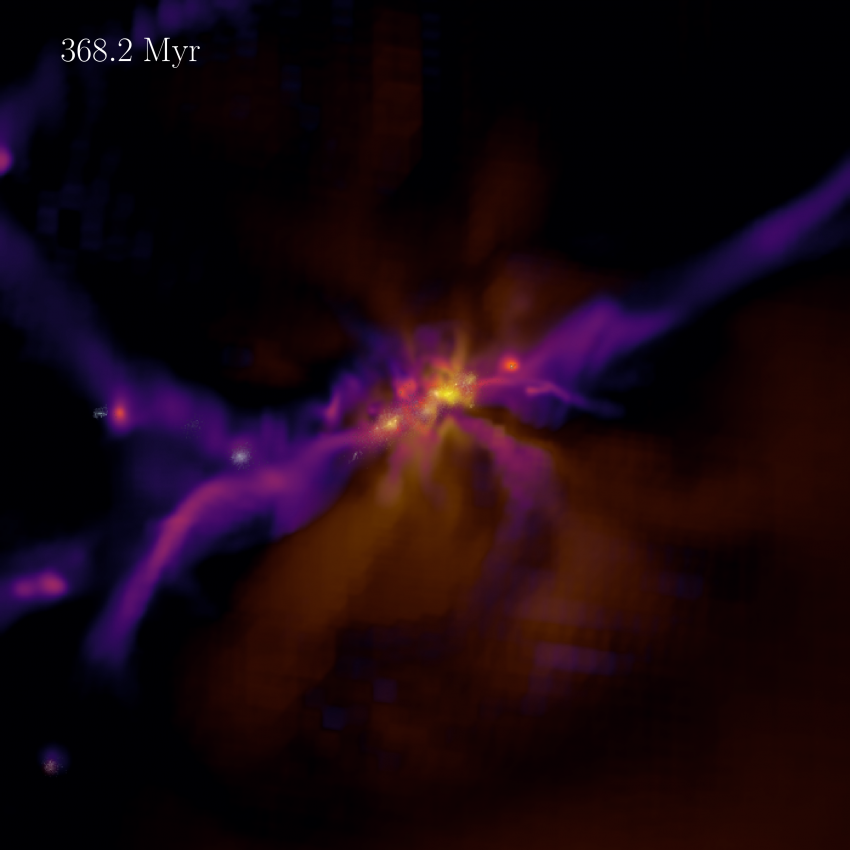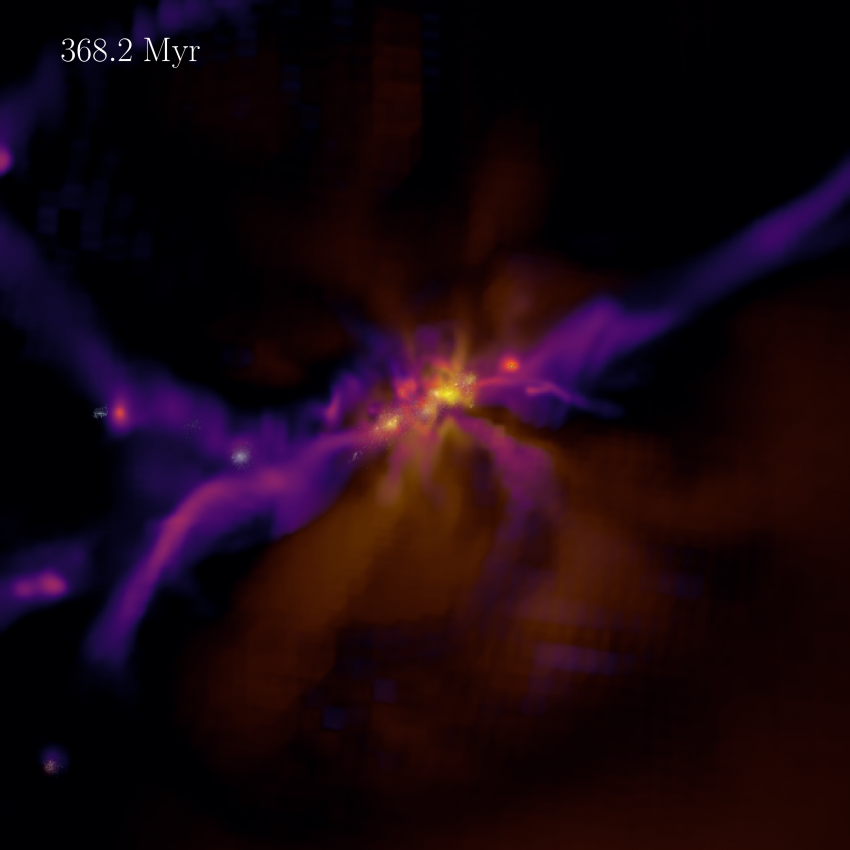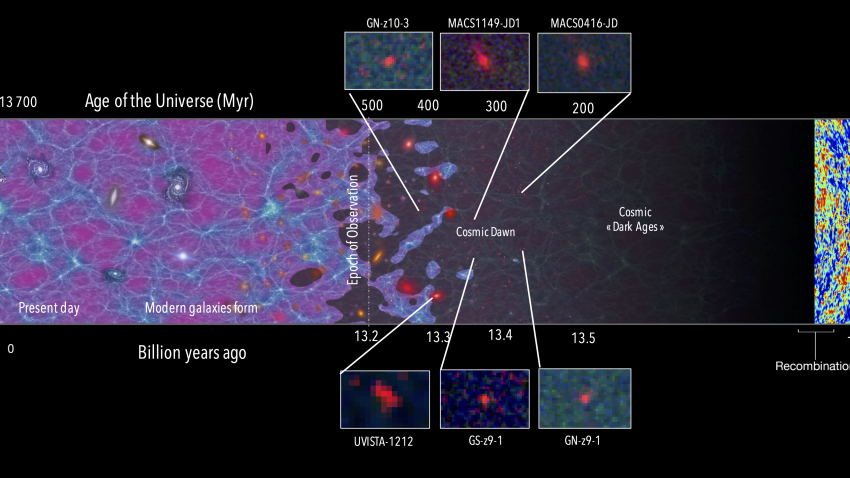New observations of six of the most distant galaxies currently known have helped to pinpoint the moment of first light in the Universe, known as ‘cosmic dawn’. The new work is published in Monthly Notices of the Royal Astronomical Society, and puts a new spotlight on what could be among the first galaxies formed in the Universe.
Today our Universe is full of light, however this was not the case until the first stars and galaxies formed. The new work narrows down the moment when the Universe was first bathed in starlight to a small window just a few hundred million years after the Big Bang. Prior to this the Universe was a dark place, with dust and gas gradually collecting via gravity to eventually form these first stars and galaxies, bringing to an end the cosmic Dark Ages.
The UK-led research team, which includes collaborators in three US institutions, examined the ages of stars contained in six galaxies seen when the Universe was 550 million years old. Detailed observations of the average ages of the stars in each galaxy were made with the world’s most powerful ground- and space-based telescopes, such as the Atacama Large Millimetre Array (ALMA) in Chile, the European Southern Observatory’s Very Large Telescope, the twin Keck telescopes in Hawaii, and the Gemini-South telescope.
“Using a well-understood age indicator based on the amount of hydrogen absorption seen in the atmospheres of different stars, we were able to infer that, even at these early observation times, these galaxies were already between 200 and 300 million years old,” said Romain Meyer, formerly a student at University College London, now a postdoctoral researcher at the Max Planck Institute for Astronomy in Heidelberg, Germany.
These new observations have pushed the earliest period of star formation back to well beyond the horizon accessible with current telescopes. However the team also predicts that the next generation of telescopes, such as the James Webb Space Telescope (JWST), due for launch later this year, will have the sensitivity to directly probe these earliest epochs of the Universe.
“What is perhaps most striking about our paper is that we predict the progenitors of galaxies like those we observed would be visible and detectable at birth with the infrared capabilities of JWST,” explained Nicolas Laporte of the University of Cambridge, the leader of the study.
He adds: “Our observations indicate that cosmic dawn occurred between 250 and 350 million years after the beginning of the Universe, and at the time of their formation, galaxies such as the ones we studied would have been sufficiently luminous to be seen with JWST.”
“We now eagerly await the successful launch of JWST, which we believe has the capability to directly witness cosmic dawn,” added co-author Richard Ellis from University College London. “Since we are made of material processed in stars, this is in some sense the search for our own origins.”
Media contacts
Dr Robert Massey
Royal Astronomical Society
United Kingdom
Tel: +44 (0)20 7292 3979
Mob: +44 (0)7802 877 699
press@ras.ac.uk
Dr Morgan Hollis
Royal Astronomical Society
United Kingdom
Mob: +44 (0)7802 877 700
press@ras.ac.uk
Science contacts
Dr Nicolas Laporte
University of Cambridge
nl408@cam.ac.uk
Dr Romain Meyer
Max Planck Institute for Astronomy
meyer@mpia.de
Prof. Richard Ellis
University College London
richard.ellis@ucl.ac.uk
Images and captions
Video of the formation and evolution of the first stars and galaxies in a virtual universe similar to our own. The simulation begins just before cosmic dawn, when the universe is devoid of starlight, and runs to the epoch 550 million years after the Big Bang when the six galaxies analysed by Dr Laporte and colleagues are being observed.
The age of the universe in millions of years is shown in the upper left. The inset focuses on the evolution of a galaxy similar to those in the recent observational study. Purple regions display the filamentary distribution of gas, composed mostly of hydrogen. White regions represent starlight and the yellow regions depict energetic radiation from the most massive stars which is capable of ionising the surrounding hydrogen gas. As massive stars rapidly reach the end of their lifetime, they erupt in violent supernova explosions which expel the surrounding gas enabling the escape of this energetic radiation. Galaxies such as the one shown continually accrete material from nearby smaller systems and quickly assemble to form the more substantial galaxies observed by the Hubble Space Telescope at later times.
Credit: Harley Katz / University of Oxford
Further information
The new work appears in, “Probing Cosmic Dawn: Ages and Star Formation Histories of Candidate z ≥9 Galaxies”, N. Laporte, R.A. Meyer, R.S. Ellis et al., Monthly Notices of the Royal Astronomical Society (2021), in press (DOI: 10.1093/mnras/stab1239).
Notes for editors
The Royal Astronomical Society (RAS), founded in 1820, encourages and promotes the study of astronomy, solar-system science, geophysics and closely related branches of science. The RAS organises scientific meetings, publishes international research and review journals, recognises outstanding achievements by the award of medals and prizes, maintains an extensive library, supports education through grants and outreach activities and represents UK astronomy nationally and internationally. Its more than 4,000 members (Fellows), a third based overseas, include scientific researchers in universities, observatories and laboratories as well as historians of astronomy and others.
The RAS accepts papers for its journals based on the principle of peer review, in which fellow experts on the editorial boards accept the paper as worth considering. The Society issues press releases based on a similar principle, but the organisations and scientists concerned have overall responsibility for their content.
Follow the RAS on Twitter, Facebook, Instagram and YouTube
Download the RAS Podcast from Audioboom




